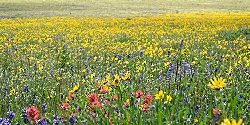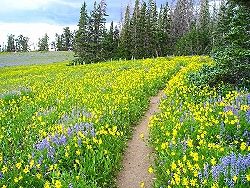
Cedar Breaks National Monument
Courtesy National Park Service, Cedar Breaks National Monument
Scientists call it neoteny, the retention of juvenile features in the adult of a species—basically, the harboring of a playful nature into adulthood. The research into the benefits of play, especially outdoor play, is becoming more replete by the day. In humans, play puts the right hemisphere of the brain into gear, that portion responsible for artistic and creative notions, imagination and insight, and holistic thought. The cerebellum and frontal lobes light up as well, increasing attunement to coordination, executive functioning, and contextual memory development. Neoteny, scientists say, is the key to a species’ adaptability and, therefore, its survival.

Cedar Breaks National Monument Courtesy National Park Service, Cedar Breaks National Monument
Robin Moore, a professor at North Carolina State University, says “the natural environment is the principle source of sensory stimulation….” “Sensory experiences,” he says, “link [our] exterior world with [our] interior, hidden, affective world.” The outdoor environment is a medium of human connection where, as Moore puts it, the “freedom to explore and play…through the senses…is essential for healthy development….” Dr. Stuart Brown, clinical researcher and founder of The National Institute for Play, behooves us in his Ted Talk on the subject to explore our individual histories of play. If you close your eyes and imagine yourself at play, where are you? The open water, a deep forest, a mountain peak, or maybe a field of wildflowers?
In his national bestseller, Last Child in the Woods, Richard Louv calls nature a “reset button.” It is the place where we are reminded of ourselves and our purpose. Australian musician Xavier Rudd sings, “Take a stroll to the nearest water’s edge/Remember your place.” It’s often proffered that in a time of industrial expectation and hyper-communication, we need the wild spaces more than ever. There’s some truth to that; but I think I’d go play there anyway, even if it wasn’t to escape the, quote-unquote, “workaday life.” I’m most human when I’m running through a field of blooming wildflowers.
I’m Josh Boling, and I’m Wild About Utah.
Credits:
Photos: Courtesy US National Park Service, Cedar Breaks National Monument
Text: Josh Boling, 2018
Sources & Additional Reading
Cedar Breaks, Plan Your Visit, National Park Service, https://www.nps.gov/cebr/planyourvisit/index.htm
Cedar Breaks National Monument, National Park Service, https://www.nps.gov/cebr/index.htm
Neoteny, Reference Terms, ScienceDaily, https://www.sciencedaily.com/terms/neoteny.htm
